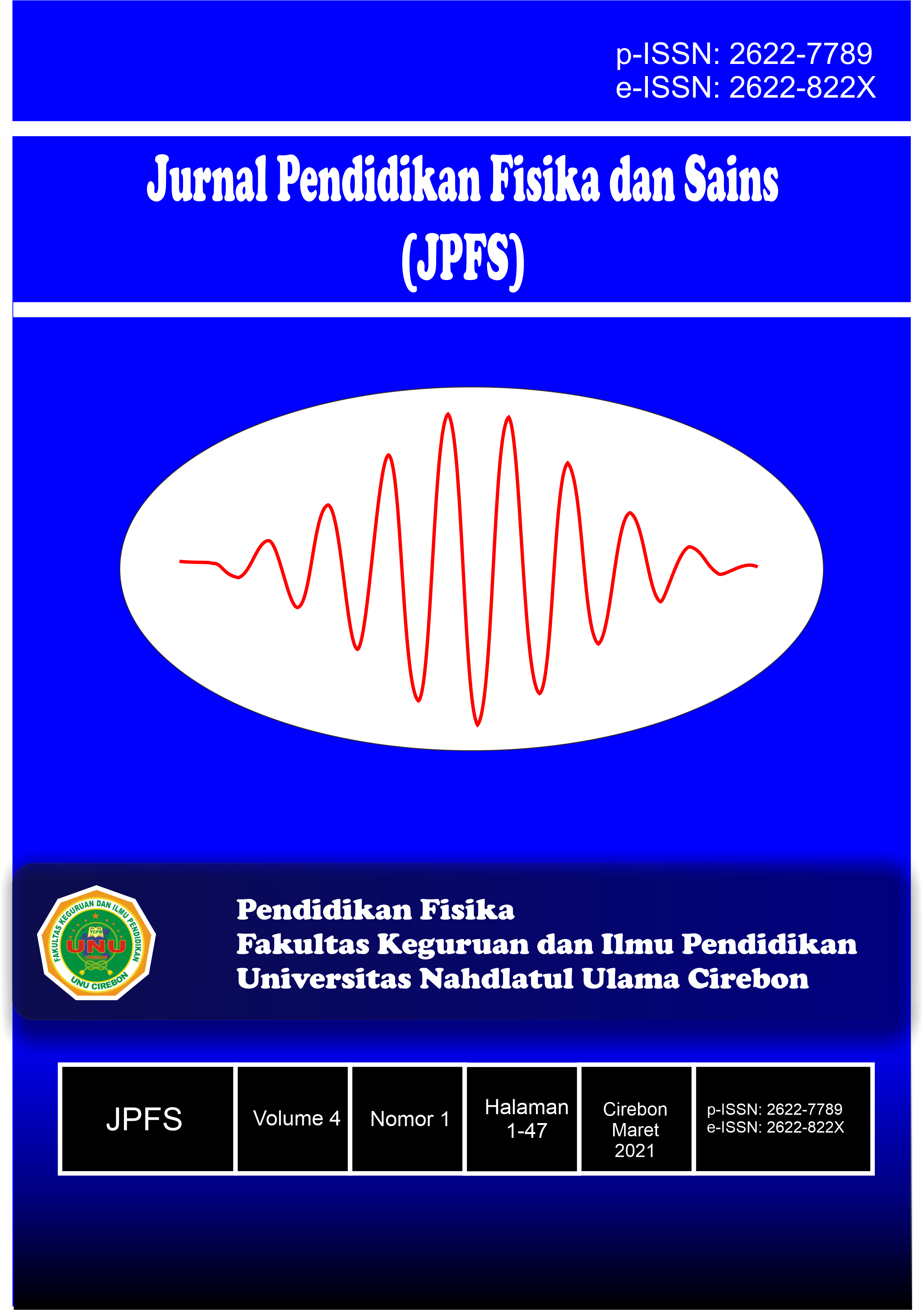Meningkatkan Hasil Belajar Siswa Konsep Laju Reaksi dengan Model Discovery PjBL Berbasis STEM di SMAN 1 Lemahabang Cirebon
DOI:
https://doi.org/10.52188/jpfs.v4i1.104Kata Kunci:
Project Based Learning (PjBL), Science Technology Engineering and Mathematics (STEM), learning outcomes, reaction rate and cycleAbstrak
This research is a classroom action research which aims to improve the chemistry learning outcomes of the reaction rate concept by using the Discovery Project Based Learning (PjBL) model based on Science, Technology, Engineering, and Mathematics (STEM) at SMAN 1 Lemahabang, Cirebon Regency. This research was conducted in two cycles, each cycle consisted of 1-2 meetings. The subjects of this study were 34 students of class XI-MIPA 3 at SMAN 1 Lemahabang. The data collection instruments used in this research were a test method for students, monitoring the conditions of the teaching and learning process and questionnaires to find out students' responses to the learning carried out. Based on the research analysis showed that in the first cycle there was an increase in student learning outcomes in the concept of reaction rate, namely the value before being given action with good and very good criteria of 11,76% and after being given action the value was 44,11%, then in the second cycle it increased to 79, 41%, while students who scored below the Minimum Completeness Criteria experienced a decline. Therefore, the use of the STEM-based Discovery PjBL model could improve the chemistry learning outcomes of students on the reaction rate material.
Referensi
Aprianty, H., Gani, A., & Pada, U.T. (2020). Implementation of Project-Based Learning Through STEM Approach To Improve Students’ Science Process Skills and Learning Outcomes. JTK: Jurnal Tadris Kimiya. 5 (2), 144-152.
Capraro, R., Caprapo, M., & Morgan, J.R. (2013). STEM Project-Based Learning. Rotterdam: Sense Publisher.
Farwati, R., Permanasari, A., Firman, H., & Suhery, T. (2017). Integrasi Project Based Learning dalam STEM Education Berorientasi pada Aktualisasi Literasi Lingkungan dan Kreativitas. Prosiding Seminar Nasional Pendidikan IPA. Universitas Sriwijaya.
Kemendikbud. (2013) Pengembangan Analisis Hasil Belajar Siswa. Jakarta: Kementerian Pendidikan dan Kebudayaan.
Mullis, I.V. (2012). TIMMS 2011 International Results in Mathematics. International
Asssociation for Ealuation of Educational Achievement.
Permanasari, A. (2016). STEM Education: inovasi dalam pembelajaran sains. Prosiding Seminar Nasional Pendidikan Sains (SNPS). Universitas Pendidikan Indonesia.
Shernoff, D.J., Sinha, S., Bressler, D.M., dan Ginsburg, L. (2017). Assesing Teacher Education and Proffessional Development Needs for the Implementatation of Integrated Approaches to STEM Education. International Journal of STEM Education, 4(1) 3, 1-16.
Sitaresmi, K.S., Saputro, S., & Utomo, S.B. (2017). Penerapan Pembelajaran Project Based Learning (PjBL) Untuk Meningkatkan Aktivitas dan Prestasi Belajar Siswa Pada Materi Sistem Periodik Unsur (SPU) Kelas X MIA 1 SMA Negeri 1 Teras Boyolali Tahun Pelajaran 2015/2016. Jurnal Pendidikan Kimia (JPK), 6 (1), 54-61.
Sudarmin. (2009). Meningkatkan Kemampuan Berpikir Mahasiswa melalui Pembelajaran Kimia Terintegrasi Kemampuan Generik Sains. Prosiding Seminar Nasional Penelitian Pendidikan dan Penerapan MIPA. Universitas Negeri Yogyakarta.
Sudarmin. (2015). Model Pembelajaran Inovatif Kreatif (Model PAIKEM dalam Konteks Pembelajaran dan Penelitian Sains Bermuatan Karakter), Semarang: Swadaya Manunggal.
Sumarni, W. & Kadarwati, S. (2020). Ethno-STEM Project-Based Learning: Its Impact to Critical and Creative Thinking Skills. Jurnal Pendidikan IPA Indonesia. 9 (1), 11-21
Syah, M. (2007). Psikologi Pendidikan dengan Pendekatan Nilai. Bandung: Remaja Rosdakarya.
Syukriah, S., Nurmaliah, C., & Abdullah A. (2020). The implementation of project-based learning model to improve students’ learning outcomes. AICMSTE 2019: IOP Conf. Series: Journal of Physics: Conf. Series, 1-8.
Tawil, M. & Liliasari. (2013). Berpikir kompleks dan ilmplementasinya dalam pembelajaran IPA. Makasar: Badan Penerbit UNM.
Triana, D., Anggraito, Y.U., & Ridlo, S. (2020). Effectiveness of Environmental Change Learning Tools Based on STEM-PjBL Towards 4C Skills of Students. Journal of Innovative Science Education. 9 (2), 191-187.
Diterbitkan
Versi
- 2021-06-07 (2)
- 2021-05-19 (1)
Cara Mengutip
Terbitan
Bagian
Copyright Transfer Agreement
The Authors submitting a manuscript do so on the understanding that if accepted for publication, copyright of the article shall be assigned to Jurnal Pendidikan Fisika dan Sains (JPFS) and Physics Education Programs of UNU Cirebon as publisher of the journal.
Copyright encompasses exclusive rights to reproduce and deliver the article in all form and media, including reprints, photographs, microfilms and any other similar reproductions, as well as translations. The reproduction of any part of this journal, its storage in databases and its transmission by any form or media, such as electronic, electrostatic and mechanical copies, photocopies, recordings, magnetic media, etc. , will be allowed only with a written permission from Jurnal Pendidikan Fisika dan Sains (JPFS) and UNU Cirebon.
Authors are permitted to disseminate published articles by sharing the link/DOI of the article at the journal. Authors are allowed to use their articles for any legal purposes deemed necessary without written permission from the journal with an acknowledgment of initial publication to this journal.
Jurnal Pendidikan Fisika dan Sains (JPFS) and UNU Cirebon and the Editorial Board make every effort to ensure that no wrong or misleading data, opinions or statements be published in the journal. In any way, the contents of the articles and advertisements published in the Jurnal Pendidikan Fisika dan Sains (JPFS) are sole and exclusive responsibility of their respective authors and advertisers.




















